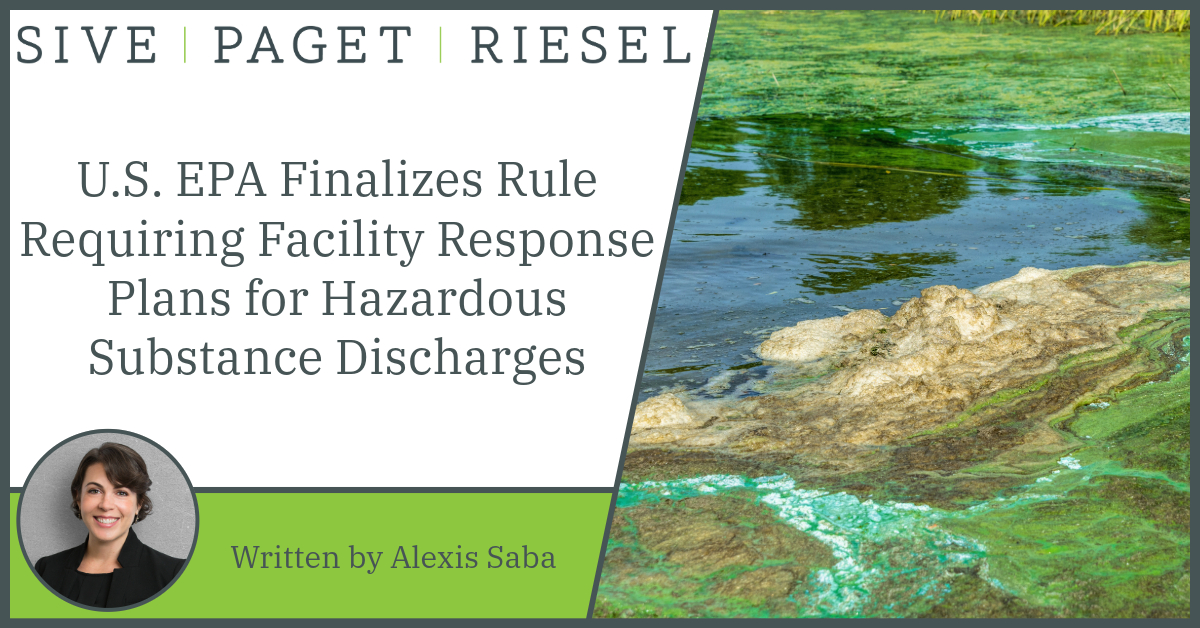Blog

On March 28, 2024, the U.S. Environmental Protection Agency (EPA) issued a final rule requiring certain onshore facilities to prepare Facility Response Plans (FRPs) for the worst-case discharges of Clean Water Act (CWA) hazardous substances. FRPs are due to EPA by June 1, 2027, or prior to the start of operations for facilities constructed after June 1, 2027. The FRP requirements are located in a new Part 118 of Title 40 of the Code of Federal Regulations (CFR).
The requirements apply to the owner or operator of any non-transportation-related onshore facility that meets the below criteria. A “non-transportation-related onshore facility” is broadly defined as: “any facility of any kind located in, on, or under any land within the United States and excludes movement of CWA hazardous substances in interstate or intrastate commerce under active shipping papers by rail, pipeline, highway vehicle, or vessel pursuant to 49 CFR Parts 171-180.” For informational purposes only, the final rule lists the types of entities that may qualify, such as gas stations, warehouses, wholesalers, waste management facilities, hospitals, museums, and other real estate.
Such non-transportation-related onshore facilities will be required to comply with the final rule and prepare FRPs where the facilities meet the following three requirements:
- The facilities contain a threshold amount of CWA hazardous substances onsite. CWA hazardous substances are listed in 40 CFR 116.4 and include numerous substances such as ammonia, benzene, chlorine, and sulfuric acid, or any solutions or mixtures containing the Section 116.4 listed substances. The threshold amount for listed substances is 1,000 times the reportable quantity, which is defined in 40 CFR 117.3; the threshold amount for solutions and mixtures is described in the final rule.
- The facilities are located within one-half mile of navigable waters or of a conveyance to navigable waters. The final rule defines “navigable waters” as “waters of the United States” (also known as WOTUS, defined in 40 CFR 120.2), adjoining shorelines, and the exclusive economic zone. The SPR Blog has been covering the changing definition of WOTUS through Supreme Court decisions and agency rulemakings, but the meaning can be difficult to parse and even differs among jurisdictions due to ongoing litigation.
- The facilities could reasonably be expected to cause substantial harm to the environment by discharging CWA hazardous substances into navigable waters or a conveyance to such waters. Covered facilities must meet at least one of the following substantial harm criteria: (a) ability to injure fish, wildlife, and sensitive environments; (b) ability to adversely impact a public water system; (c) ability to injure public receptors; or (d) have had a reportable CWA hazardous substance discharge within the last five years that reached navigable waters. The final rule includes detailed provisions on each criterion.
FRPs are designed to prepare for and respond to the worst-case discharges of CWA hazardous substances, meaning the largest foreseeable discharge in adverse weather conditions, including a discharge resulting from fire or explosion. The final rule includes the parameters that covered owners and operators must use for modeling worst-case discharges.
The final rule details the required scope and content of FRPs. In summary, FRPs must include:
-
- Facility and owner/operator information.
- A hazard evaluation for a worst-case discharge.
- Record of prior CWA hazardous substances discharges.
- Discharge detection systems.
- Response personnel and equipment.
- Training procedures.
- Procedures for notifying government authorities and public water providers.
- Evacuation plans.
- Containment measures and other response actions.
- Plan to dispose of contaminated cleanup materials.
Owners or operators must review and recertify their FRPs at least every five years, or earlier if there is a change to the facility that may materially affect the response to or potential for a worst case discharge, or if a CWA hazardous substance is added to or removed from the facility.
Therefore, it would be prudent for any facility that uses or stores CWA hazardous substances to evaluate potential coverage under EPA’s new rule, including the quantity of CWA hazardous substances, proximity to navigable waters, and potential for substantial harm to the environment should there be a discharge of hazardous substances.
Inflation Reduction Act: Recent Guidance and the Path Forward in 2024
On February 20 and February 21, 2024, the Internal Revenue Service (IRS) and the Department of the Treasury (Treasury) held a public hearing on proposed...
Read MoreNYSDEC Seeks Input on Regulations Implementing Major Expansion of State’s Freshwater Wetlands Jurisdiction
On January 3, 2024, NYSDEC announced an Advanced Notice of Proposed Rule Making for potential revisions to its freshwater wetlands regulations, accompanied by a complete...
Read MoreVineyard Wind 1 Comes Online; Still Faces Lawsuits
On January 2, 2024, the Vineyard Wind 1 project started producing power for the United States grid, becoming the second commercial-scale offshore wind project to...
Read MoreCovered New Jersey Buildings Must Meet New Benchmarking Requirement By December 31
December 31, 2023 marks the final deadline for compliance with the first year of New Jersey’s building energy and water benchmarking law. The New Jersey...
Read MoreChallenge to Rye City Planning Commission Approval of Wainwright House’s Special Permit Dismissed
On November 9, 2023, Acting Justice Robert J. Prisco of the New York State Supreme Court, Westchester County, dismissed an Article 78 petition brought by...
Read More